Related Research Articles
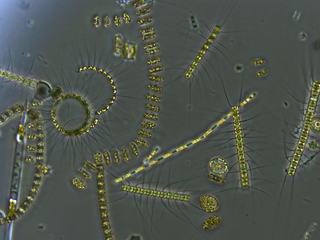
Phytoplankton are the autotrophic (self-feeding) components of the plankton community and a key part of ocean and freshwater ecosystems. The name comes from the Greek words φυτόν, meaning 'plant', and πλαγκτός, meaning 'wanderer' or 'drifter'.
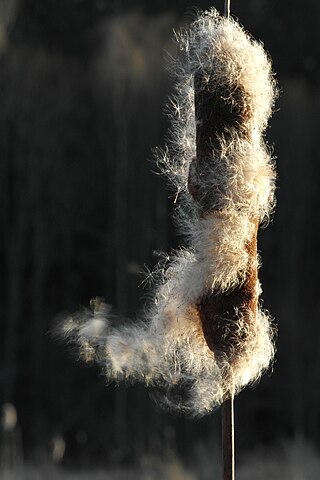
Typha is a genus of about 30 species of monocotyledonous flowering plants in the family Typhaceae. These plants have a variety of common names, in British English as bulrush or reedmace, in American English as reed, cattail, or punks, in Australia as cumbungi or bulrush, in Canada as bulrush or cattail, and in New Zealand as reed, cattail, bulrush or raupo. Other taxa of plants may be known as bulrush, including some sedges in Scirpus and related genera.

Wetlands, or simply a wetland, is a distinct ecosystem that is flooded or saturated by water, either permanently or seasonally. Flooding results in oxygen-free (anoxic) processes prevailing, especially in the soils. The primary factor that distinguishes wetlands from terrestrial land forms or water bodies is the characteristic vegetation of aquatic plants, adapted to the unique anoxic hydric soils. Wetlands are considered among the most biologically diverse of all ecosystems, serving as home to a wide range of plant and animal species. Methods for assessing wetland functions, wetland ecological health, and general wetland condition have been developed for many regions of the world. These methods have contributed to wetland conservation partly by raising public awareness of the functions some wetlands provide. Constructed wetlands are designed and built to treat municipal and industrial wastewater as well as to divert stormwater runoff. Constructed wetlands may also play a role in water-sensitive urban design.

Aquatic plants are plants that have adapted to living in aquatic environments. They are also referred to as hydrophytes or macrophytes to distinguish them from algae and other microphytes. A macrophyte is a plant that grows in or near water and is either emergent, submergent, or floating. In lakes and rivers macrophytes provide cover for fish, substrate for aquatic invertebrates, produce oxygen, and act as food for some fish and wildlife.

A marsh is - according to ecological definitions - a wetland that is dominated by herbaceous rather than woody plant species. More in general, the word can be used for any low-lying and seasonally waterlogged terrain. In Europe and in agricultural literature low-lying meadows that require draining and embanked polderlands are also referred to as marshes or marshland.
Freshwater ecosystems are a subset of Earth's aquatic ecosystems. They include lakes, ponds, rivers, streams, springs, bogs, and wetlands. They can be contrasted with marine ecosystems, which have a larger salt content. Freshwater habitats can be classified by different factors, including temperature, light penetration, nutrients, and vegetation. There are three basic types of freshwater ecosystems: Lentic, lotic and wetlands. Freshwater ecosystems contain 41% of the world's known fish species.

The benthic zone is the ecological region at the lowest level of a body of water such as an ocean, lake, or stream, including the sediment surface and some sub-surface layers. The name comes from ancient Greek, βένθος (bénthos), meaning "the depths." Organisms living in this zone are called benthos and include microorganisms as well as larger invertebrates, such as crustaceans and polychaetes. Organisms here generally live in close relationship with the substrate and many are permanently attached to the bottom. The benthic boundary layer, which includes the bottom layer of water and the uppermost layer of sediment directly influenced by the overlying water, is an integral part of the benthic zone, as it greatly influences the biological activity that takes place there. Examples of contact soil layers include sand bottoms, rocky outcrops, coral, and bay mud.

A constructed wetland is an artificial wetland to treat sewage, greywater, stormwater runoff or industrial wastewater. It may also be designed for land reclamation after mining, or as a mitigation step for natural areas lost to land development. Constructed wetlands are engineered systems that use the natural functions of vegetation, soil, and organisms to provide secondary treatment to wastewater. The design of the constructed wetland has to be adjusted according to the type of wastewater to be treated. Constructed wetlands have been used in both centralized and decentralized wastewater systems. Primary treatment is recommended when there is a large amount of suspended solids or soluble organic matter.

An aquatic ecosystem is an ecosystem found in and around a body of water, in contrast to land-based terrestrial ecosystems. Aquatic ecosystems contain communities of organisms—aquatic life—that are dependent on each other and on their environment. The two main types of aquatic ecosystems are marine ecosystems and freshwater ecosystems. Freshwater ecosystems may be lentic ; lotic ; and wetlands.

Periphyton is a complex mixture of algae, cyanobacteria, heterotrophic microbes, and detritus that is attached to submerged surfaces in most aquatic ecosystems. The related term Aufwuchs refers to the collection of small animals and plants that adhere to open surfaces in aquatic environments, such as parts of rooted plants.
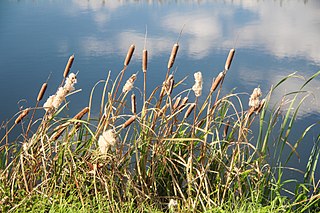
Typha latifolia, better known as broadleaf cattail, is a perennial herbaceous plant in the genus Typha. It is found as a native plant species in North and South America, Eurasia, and Africa.

River ecosystems are flowing waters that drain the landscape, and include the biotic (living) interactions amongst plants, animals and micro-organisms, as well as abiotic (nonliving) physical and chemical interactions of its many parts. River ecosystems are part of larger watershed networks or catchments, where smaller headwater streams drain into mid-size streams, which progressively drain into larger river networks. The major zones in river ecosystems are determined by the river bed's gradient or by the velocity of the current. Faster moving turbulent water typically contains greater concentrations of dissolved oxygen, which supports greater biodiversity than the slow-moving water of pools. These distinctions form the basis for the division of rivers into upland and lowland rivers.
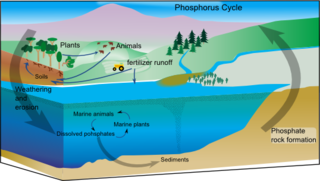
The phosphorus cycle is the biogeochemical cycle that describes the movement of phosphorus through the lithosphere, hydrosphere, and biosphere. Unlike many other biogeochemical cycles, the atmosphere does not play a significant role in the movement of phosphorus, because phosphorus and phosphorus-based compounds are usually solids at the typical ranges of temperature and pressure found on Earth. The production of phosphine gas occurs in only specialized, local conditions. Therefore, the phosphorus cycle should be viewed from whole Earth system and then specifically focused on the cycle in terrestrial and aquatic systems.
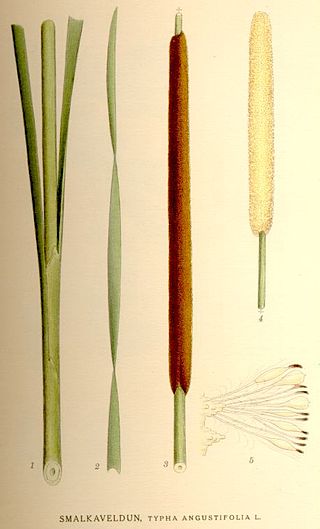
Typha angustifolia L. is a perennial herbaceous plant of genus Typha. This cattail is an "obligate wetland" species that is commonly found in the northern hemisphere in brackish locations.
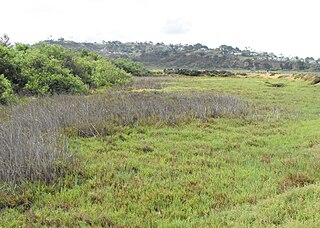
Brackish marshes develop from salt marshes where a significant freshwater influx dilutes the seawater to brackish levels of salinity. This commonly happens upstream from salt marshes by estuaries of coastal rivers or near the mouths of coastal rivers with heavy freshwater discharges in the conditions of low tidal ranges.
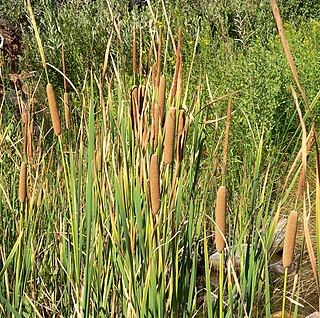
Typha domingensis, known commonly as southern cattail or cumbungi, is a perennial herbaceous plant of the genus Typha.
The Society for Freshwater Science (SFS) is an international scientific society whose members study freshwater ecosystems and ecosystems at the interface between aquatic and terrestrial habitats.

Typha × glauca is a hybrid species of plant originating as a cross between T. angustifolia and T. latifolia. It shows invasive behavior in the Midwestern United States

Human activities affect marine life and marine habitats through overfishing, habitat loss, the introduction of invasive species, ocean pollution, ocean acidification and ocean warming. These impact marine ecosystems and food webs and may result in consequences as yet unrecognised for the biodiversity and continuation of marine life forms.
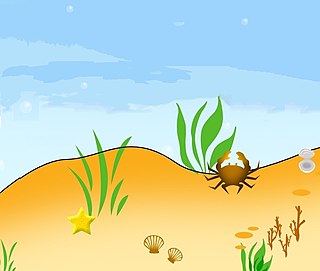
Phytobenthos (from Greek φυτόν and βένθος are autotrophic organisms found attached to bottom surfaces aquatic environments, such as rocks, sediments, or even other organisms. This photosynthetic community includes single-celled or filamentous cyanobacteria, microalgae, and macrophytes. Phytobenthos are highly diverse, and can be found in freshwater and marine environments, as well as transitional water systems. However, their distribution and availability still depend on the factors and stressors that exist in the environment. Because phytobenthos are autotrophs, they need to be able to subsist where it is still possible to perform photosynthesis. Similar to phytoplankton, phytobenthos contribute to the aquatic food web for grazers and heterotrophic bacteria, and researchers have also been studying their health as an indicator for water quality and environmental integrity of aquatic ecosystems.
References
- 1 2 3 "Our People: Founding Dean, Institute of Environmental Sustainability: Institute of Environmental Sustainability: Loyola University Chicago". www.luc.edu. Retrieved 2018-11-08.
- 1 2 "Why the Next Big Environmental Breakthrough Could Start in Chicago". Chicago magazine. Retrieved 2018-11-08.
- 1 2 "7 Eco-Champions Bringing Positive Change and Sustainability to Chicago". Make It Better - Family, Food, Finances & Philanthropy. 2018-03-19. Retrieved 2018-11-08.
- ↑ "Jesuit Friends and Alumni". Jesuitmidwest.org. Retrieved November 10, 2018.
- 1 2 "Nancy C. Tuchman: Biology, Department of: Loyola University Chicago". www.luc.edu. Retrieved 2018-11-10.
- ↑ "Nancy Tuchman, Ph.D." HealingEarth. 2013-03-12. Retrieved 2018-11-10.
- ↑ Lishawa, Shane C.; Jankowski, Kathijo; Geddes, Pamela; Larkin, Daniel J.; Monks, Andrew M.; Tuchman, Nancy C. (2014). "Denitrification in a Laurentian Great Lakes coastal wetland invaded by hybrid cattail ( Typha × glauca )". Aquatic Sciences. 76 (4): 483–495. doi:10.1007/s00027-014-0348-5. S2CID 15571527 . Retrieved 2018-11-10.
- ↑ "Nancy Tuchman, Ph.D. | Catholic Climate Covenant". catholicclimatecovenant.org. Retrieved 2018-11-10.
- 1 2 "Loyola University Chicago champions social and environmental justice [video] | U.S. Green Building Council". www.usgbc.org. Retrieved 2018-11-14.
- ↑ Owen, Ruggerio (September 21, 2016). "Loyola Named Seventh Greenest University in the Nation". Loyola Phoenix. Retrieved 2018-11-14.
- ↑ "Officers & Committees | Society for Freshwater Science". freshwater-science.org. Retrieved 2018-11-13.
- ↑ Angeloni, Nicholas L.; Jankowski, Kathi Jo; Tuchman, Nancy C.; Kelly, John J. (2006). "Effects of an invasive cattail species (Typha x glauca) on sediment nitrogen and microbial community composition in a freshwater wetland". FEMS Microbiology Letters. 263 (1): 86–92. doi: 10.1111/j.1574-6968.2006.00409.x . ISSN 0378-1097. PMID 16958855.
- ↑ Tuchman, Nancy C.; Wetzel, Robert G.; Rier, Steven T.; Wahtera, Kirk A.; Teeri, James A. (2002). "Elevated atmospheric CO2 lowers leaf litter nutritional quality for stream ecosystem food webs". Global Change Biology. 8 (2): 163–170. Bibcode:2002GCBio...8..163T. doi:10.1046/j.1365-2486.2002.00460.x. ISSN 1354-1013. S2CID 85728019.
- ↑ Johnson, Ronald E.; Tuchman, Nancy C.; Peterson, Christopher G. (1997). "Changes in the Vertical Microdistribution of Diatoms within a Developing Periphyton Mat". Journal of the North American Benthological Society. 16 (3): 503–519. doi:10.2307/1468140. ISSN 0887-3593. JSTOR 1468140. S2CID 84086897.
- ↑ Tuchman, NC; Schollett, MA; Rier, ST; Geddes, P (2006). "Differential Heterotrophic Utilization of Organic Compounds by Diatoms and Bacteria under Light and Dark Conditions". Hydrobiologia. 561 (1): 167–177. doi:10.1007/s10750-005-1612-4. ISSN 0018-8158. S2CID 17718937.
- ↑ Janus, LR; Angeloni, NL; McCormack, J; Rier, ST; Tuchman, NC; Kelly, JJ (2005). "Elevated Atmospheric CO2 Alters Soil Microbial Communities Associated with Trembling Aspen (Populus tremuloides) Roots". Microbial Ecology. 50 (1): 102–109. CiteSeerX 10.1.1.524.7680 . doi:10.1007/s00248-004-0120-9. ISSN 0095-3628. PMID 16052378. S2CID 29579344.
- ↑ Tuchman, Nancy C.; Larkin, DJ; Geddes, P; Wildova, R; Jankowski, K; Goldberg, E (2009). "Patterns of environmental change associated with Typha x glauca invasion in a Great Lakes coastal wetland". Wetlands. 29 (3): 964–975. doi:10.1672/08-71.1. ISSN 0277-5212. S2CID 28937488.
- ↑ "Healing Earth". HealingEarth. Retrieved 2018-11-10.
- ↑ Tuchman, Nancy (2014). "Preferential Option for the Earth".
{{cite journal}}: Cite journal requires|journal=(help) - ↑ "Opinion: The pope is talking to you, Chicago". Chicago Sun-Times. Retrieved 2018-11-10.
- ↑ Tuchman, Donald J. Wuebbles and Nancy C. "Cold truth". chicagotribune.com. Retrieved 2018-11-10.
- ↑ "Expanded Reason Award for Healing Earth | Ecology and Jesuits in Communication". www.ecojesuit.com. 31 October 2017. Retrieved 2018-11-08.
- ↑ "CMU names December commencement speakers | Central Michigan University". www.cmich.edu. Retrieved 2018-11-13.